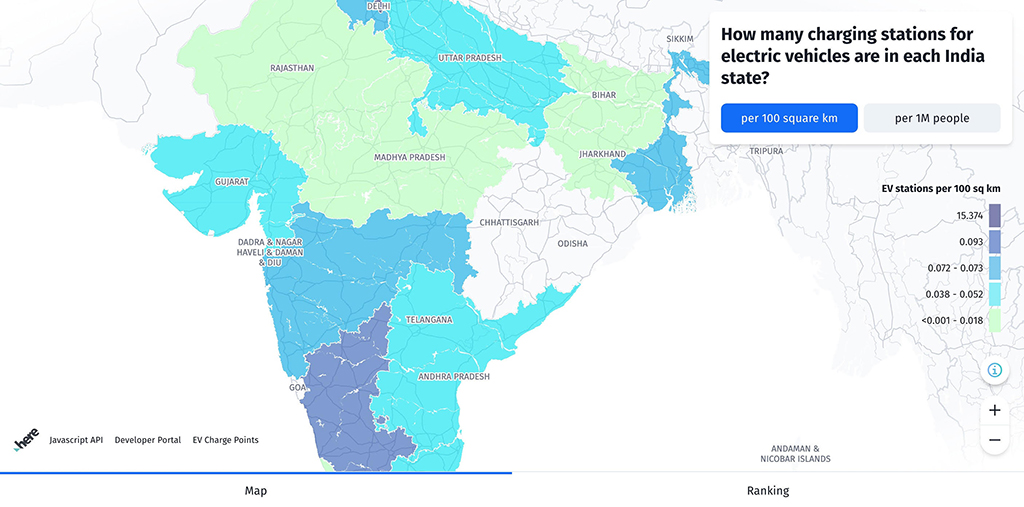
According to reports, the population of EVs in India is expected to reach 4 million by the end of the year and in the next two years, it will reach 30 million. However, despite having over millions of EVs on the roads, there are insufficient charging stations operational in public places across India. HERE Technologies has developed two interactive maps, one of which to show where these charging points are clustered across India. This map leverages HERE EV Charge Points APIs, providing lists of charging stations within a specified area, including data on connector types, opening hours, and their location. N. Balasubramanian spoke to Abhijit Sengupta, Senior Director and Head of Business for Southeast Asia and India at HERE Technologies, to find out more
What sparked the creation of the interactive maps and what issues do they look to address?
Electric vehicles are one of the key trends we have seen developing in recent times and probably one of the most important ones across the OEM / automotive ecosystem. Therefore, when we started looking at this ecosystem and spoke to our customers and various other stakeholders, we realized the need to understand the ecosystem better. Not only us but we also need to help our customers and our customers’ customers understand it better, especially the drivers who would be using the electric vehicles. We wanted to leverage our thought leadership in the segment and help our customers and other stakeholders understand how the ecosystem works which is why we have come up with these interactive maps to help identify EV charging stations and other aspects of the EV ecosystem. It is also an effort to raise awareness among EV users and actively participate in the evolving EV ecosystem.
Can you help us understand a bit more about this algorithm based on which the maps function?
There are a couple of ways in which we provide our routing product for OEMs. One is the HERE Navigation which is basically a navigation application that can be embedded on any OEM product. So basically the in-vehicle infotainment system can use our application which is full stack solution that includes our application, software development kit and various other packages on top of which various services can be run.
On the other hand, we have various API’s, one of which is the EV Charge Points API, that can run on top of an application developed by the OEM. So when we write our routing algorithm for EVs, at the SDK level or at the application level, we factor in the wealth of information we have. Thanks to our mastery over the algorithm over the last 30-35 years, we know how the various data works for routing, what level of information is required from the ground level such as time restrictions, speed limit, traffic information, so on and so forth. We overlay such information related to the EV charging point to make it more intelligent and driving ready. So basically our algorithm ensures the driver is directed to the nearest EV charging point via the most efficient and optimal route.

So, to offer such a solution, keeping tracking of the public EV charging points across the country becomes key. How do you ensure this dynamic information is tracked so that your system is up to date?
Yeah, that’s a very important question because it links back to how we keep our maps fresh. As part of our strategy for this, we have a full team dedicated to acquire such data; they work with various aggregators, super aggregators, OEMs, etc. to get the data. On one side, we work with the OEMs because they become our data supplier; in fact, they also want this data to be published in the map so it’s a kind of symbiotic relationship between us and the OEMs. Secondly, there are these private companies who have their own charging points and cater to multiple OEMs. We work with them as well as part of our sourcing strategy. Thirdly, we work with various aggregators who work closely with the OEMs and private charging solution providers. So, in summary, we have a structured content sourcing strategy that kind of drives our coverage of all the EV charging points across the geography. And, as indicated before, we don’t provide information only about the location of the charging points but also dynamic information such as whether the charging point is functional, will there be a waiting time for charging, etc.
What kind of progress has HERE made in the Indian EV market and how are discussions with potential customers going?
On the EV OEM side, we are in talks with a number of them, but they are yet to launch our services. We are still waiting to see the actual deployment but are in various stages of discussions with them. On the non-OEM side as well, we’re having conversations with multiple companies and are exploring different ways to help them drive the deployment of EVs. We see significant interest coming from them and they see our thought leadership and the value which we bring to the conversation. So, when we speak next time, hopefully we can share some names with you.
What is your view on the future potential of the Indian EV market? Over the medium- to long-term, how do you see the ecosystem evolving and what position would HERE want to take in the EV revolution?
The starting position for us in every market including India is to bring our thought leadership around the EV ecosystem, because we believe that we have a very strong horizontal play across various segments to make the EV ecosystem and EV deployment successful. On one side, we will work with the OEMs for the routing application and on the other side, we will work with other stakeholders in infrastructure planning to facilitate the deployment of EVs. So I think over the near- or mid-term future, our play in the EV space is going to be more and more significant.
The core value which we bring to this conversation is a deep understanding of location technology so wherever location comes into play, we will bring in our products and services around them, some of which are already available and extensively used.
We have maps for over 200 countries so we know how every country is very different; but our strength is on making the map very specific and relevant to each country. We will deploy a similar strategy for our EV journey, making our solutions relevant for every country and ensuring all the OEMs and other ecosystem players like the utility companies, government agencies, aggregators, etc. are find value in what we deliver. We are having multiple conversations with potential customers and are very excited with the way things are unfolding on the EV side.